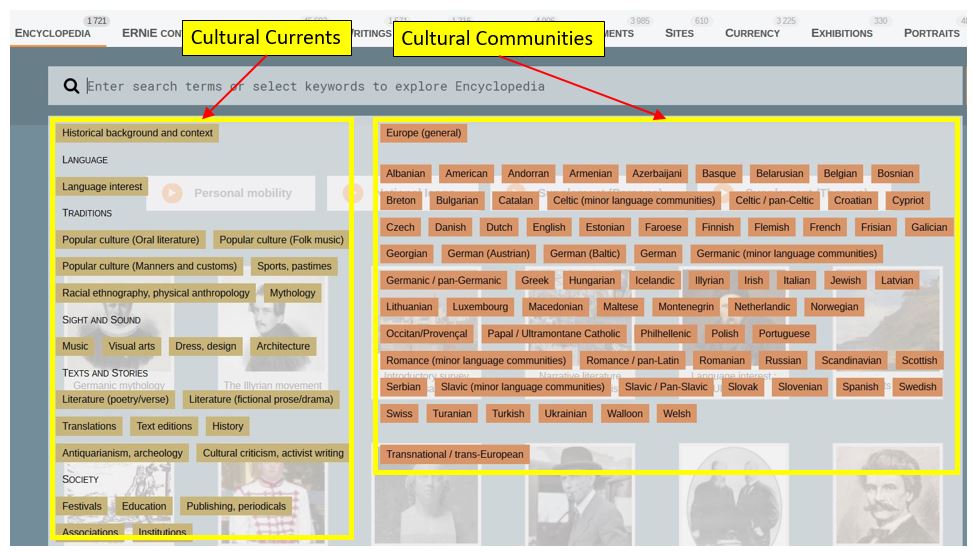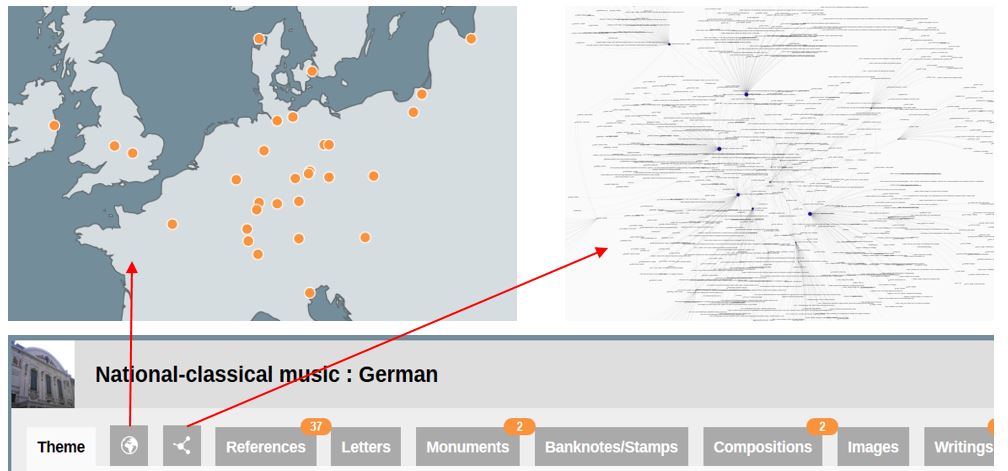Coverage and Structure of the Encyclopedia of Romantic Nationalism in Europe
Contents
- Focus and main aims
- Culture across space: “Europe” and its “Cultural Communities”
- Culture over time: the Romantic Century and its “Cultural Currents”
- ERNiE’s Person-Related Articles and Thematic Articles [this page]
Thematic Articles
A “theme”, in ERNiE, consists of the intersection between
- a Cultural Current (a genre or field in artistic production or knowledge production, e.g. Visual Arts or History-writing).
- a Cultural Community (self-articulating “nationality”, e.g. Breton or Swedish) and
ERNiE distinguishes c. 20-25 Cultural Currents and c. 70-75 Cultural Communities, so that theoretically the number of Thematic Articles could come to c. 1600; but not all Communities are in all respects sharply distinct, and not all Currents are meaningfully represented everywhere.

Cultural Currents
The Cultural Currents are, for the sake of searchability, grouped into five large fields:
- Language, also covering linguistic interest and language-political debates
- Traditions, covering immaterial and traditional culture, comprising:
- Oral literature; Folk music; Manners and Customs; Sports and pastimes; Ethnography; Mythology
- Sight and Sound, covering performative and visual culture, comprising:
- Musical culture; Visual arts; Dress/design; Architecture
- Texts and Stories, covering textual, literary and historical culture, comprising:
- Literature (lyrical, narrative-fictional, dramatic); Translations; Text editions; History-writing; Antiquarianism/archeology; Cultural criticism and activist writing
- Society, covering aspects of sociocultural mobilization, comprising:
- Festivals/Commemorations; Education; Publishing and periodicals; Associations; Institutions
At the head of the dropdown list, the rubric Historical background and Context can be used in combination with a Cultural Community tag for general background articles on the political and social history of that nationality during the 19th century.
Cultural Communities
Cultural Communities are listed alphabetically; a full list of these is given under the tab “Cultural Currents and Communities”, with cross-references for those communities not separately noted in the on-screen drop-down menu (e.g. Ruthenian > Ukrainian; Corsica > Romance - minor language communities).
- The rubric Europe (general) at the top of the list tags survey articles that cover a certain Cultural Current as a whole in its pan-European manifestation.
- A rubric Transnational/trans-European is appended at the bottom of the drop-down list for occasional sightlines reaching beyond the European continent and for vaguely-territorialized cultural identities (ethnic, like Saami or Roma).
- Cultural Community tags are not like pigeon holes, mutually exclusive and distinct. There are overlaps and sliding transitions between Belgian and either Flemish or Walloon, or between Flemish, Dutch and (Greater-)Netherlandic. Two or more of these tags are often used in combination. In other cases, certain regional specificities carry ad-hoc identifying tags which stand in a subsidiary position to a larger category, e.g. German (Austrian) and German (Baltic) alongside German.
- Name-forms are generally adjectival, partly in order to avoid “groupism”, and also to stress that these rubrics do not map onto fixed countries or territories, or onto the shifting territorial arrangements of post-1918 Europe. The nomenclature is primarily ethnolinguistic (given the prioritization of language in European nation-building movements), but leaves room for certain cultural communities where a self-perceived identity was articulated in diverse languages (Belgian, Jewish, Scottish, Swiss, Irish).
- Certain manifestations of regionalism are briefly noted under the most relevant Cultural Community.
- The Communities list also names identities that attracted macronationalistic movements, such as Celtic, Illyrian, (Greater-)Netherlandic, Scandinavian, Slavic and Turanian.
In the case of Thematic Articles, as with Person-Related Articles, it is recommended that users explore the wider connections by means of the relational tabs.